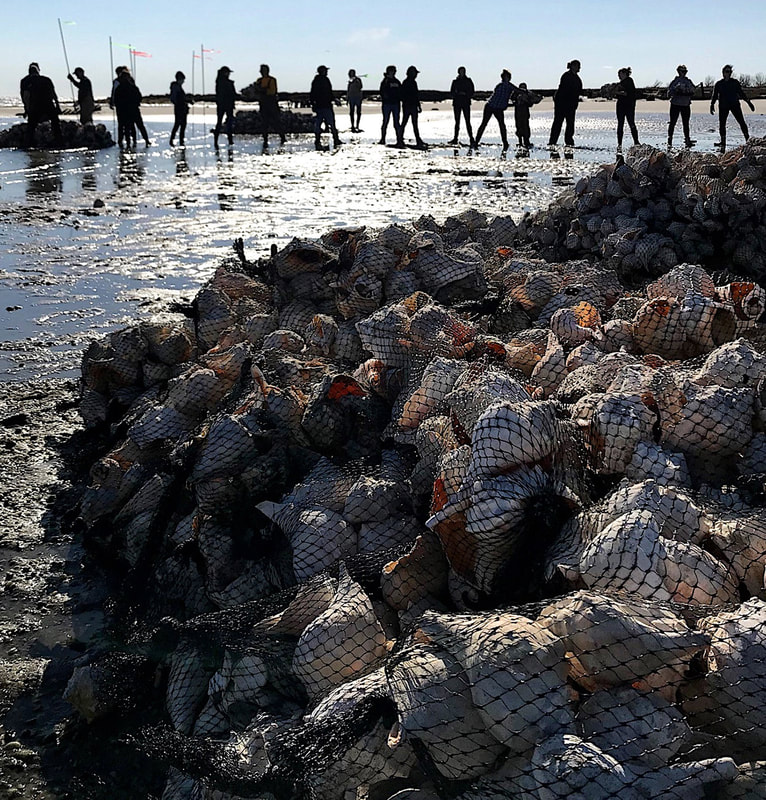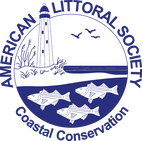|
It has been nearly seven years since Hurricane Sandy made landfall in southeastern New Jersey, which is hard to forget given that signs of that devastating storm still linger around the state. However, in that time the American Littoral Society and its partners were able to deal with the initial environmental damage along NJ’s Delaware Bayshore and begin restoring critical habitat for the horseshoe crab and shorebirds, such as the red knot. While those efforts have yielded some encouraging results, the Red Knot population remains near historic lows and much more work needs to be done to ensure it rebounds. Project partners include community and state leaders, leading global shorebird biologists and local contractors, with funding from the National Fish and Wildlife Foundation (NFWF), William Penn Foundation, and the Dodge Foundation. Now the Littoral Society is preparing for the next stage of work to protect and restore the coast in that area with the signing of a U.S. Army Corps of Engineers' (USACE) 10-year regional permit for restoring beach and creating oyster reefs along the Delaware Bayshore of Cape May and Cumberland counties. On October 29, 2012, Hurricane Sandy slammed into New Jersey, dumping tons of debris onto Delaware Bay beaches and stripping them of sand. The immediate concern was that nearly 70 percent of horseshoe crab beach habitat had been destroyed and the loss imperiled not only the horseshoe crabs that spawn there, but also shorebirds like the Federally-listed Red Knot, which stop on those beaches each spring to feed on crab eggs before flying to their nesting grounds in the Canadian Arctic.
The birds and crabs help fuel a multi-million-dollar annual ecotourism industry in New Jersey’s Bayshore region. However, despite a New Jersey moratorium on the crab harvest since 2008, reduced quotas for three other bay states that still take crabs, and a bay-wide ban on harvesting egg-laying females, shorebird numbers have not recovered to anywhere near their levels in the 1980s before the over-harvest of crabs began. “It was a crisis response; we were racing against a firm deadline of the horseshoe crabs arriving on the beach,” said Tim Dillingham, executive director of the American Littoral Society. “But we were also intent on conserving and rebuilding the natural environment of the shoreline in order to restore a healthy and resilient Delaware Bay. ” In 2014, the Society was awarded $4.75 million from NFWF and an additional $1M from US Fish and Wildlife Service (USFWS) to continue and expand restoration efforts more proactively across Cape May and Cumberland Counties. With that funding, the Society added over 200,000 cubic yards of sand to eight beaches, restoring over 56.5 acres of horseshoe crab spawning and shorebird foraging habitat. In addition, the Society created five intertidal oyster reefs to keep that sand on the beaches; restored one acre of marsh using innovative dredge material and containment methods; created a tool to model sand movement and identify predominant physical characteristics to enable improved restoration planning; engaged thousands of volunteers; tagged over 18,000 horseshoe crabs; and implemented a US military veterans’ program. In 2018, one of those beaches was named best restored beach in the nation by the American Shore & Beach Preservation. According to the ASBPA, Thompsons Beach was recognized because it had both environmental and economic benefits, used a science-based process, and showed the benefits of public/private partnerships. In 2015, the Society was also received the New Jersey Governor’s Environmental Excellence Award for restoration work along Delaware Bay. The results of that work can also be seen in denser horseshoe crab egg clusters on other restored beaches, which likely contributed to estimates that nearly all of the known Red Knot population (approximately 29,000 birds) foraged on Society-restored beaches prior to flying to artic nesting grounds this year. The years of study also provided a firmer understanding of marsh/beach interactions and the know-how to employ collected data to adaptively manage these restored habitats moving forward. The years of study also provided a firmer understanding of marsh/beach interactions and the know-how to employ collected data to adaptively manage these restored habitats moving forward. All of that work provided the foundation for the USACE 10-year regional beach and oyster reef restoration permit, which was signed in April 2019. This innovative permit will allow the Society to pursue its future conservation work more efficiently and effectively. “Our continued ability to restore these beaches and build oyster reefs will allow us to provide where crabs and birds will not only survive, but thrive,” said Capt. Al Modjeski, Restoration Program Director for the American Littoral Society. “The 10-year permit will also allow help to expedite regulatory review time and let us be more proactive in meeting the needs of the Delaware Bay moving forward.” Like the red knots that recently migrated north, the Society’s large bayshore restoration grants have also departed. However, the USACE permit, along with permits from the state, a sound restoration prioritization plan, and the Littoral Society’s proven record of success provide a solid framework for more funding and the potential for national appropriations. In the last year, the work has benefitted from awards from the Delaware Basin Conservation Act, USFWS Partners Program and the National Fish and Wildlife Foundation. Going forward, the Society plans to restore up to one linear mile of beach and create three intertidal reefs per year, while working with state and Federal partners to secure additional funding to hopefully do even more. The Society is also backing a campaign aimed at fully restoring the crab population by 2030 from its current status, which is estimated at only 30 percent of the bay’s carrying capacity. Without a significant and sustained increase in horseshoe crabs, there will be continued doubts about the long-term survival of the Red Knot. Only about 31,000 of those birds still exist, up from about 10,000 in 2000, but still only a tiny fraction of past numbers. While the numbers have been creeping up in recent annual surveys, consensus is that the species still isn’t numerous enough to withstand shocks such as severe weather in its Arctic breeding grounds, or development along its migration route, leaving it vulnerable to eventual extinction. The bird was listed by the federal government as a threatened species in 2015. If the crab population is restored, it will also benefit fish and other marine species that feed on the crabs, and which have themselves been depleted by the crabs’ decline. In the face of more frequent storms, climate change, and sea level rise, it is clear that long-term efforts are essential to not only restore important habitat, but also forge a path for survivability of the Bay’s ecology and culture. The American Littoral Society intends to play a role in future chapters focused on sustaining both animal and human living spaces in the region, while ensuring the coast can more quickly recover from future storms. Comments are closed.
|
Archives
July 2024
Categories
All
|


